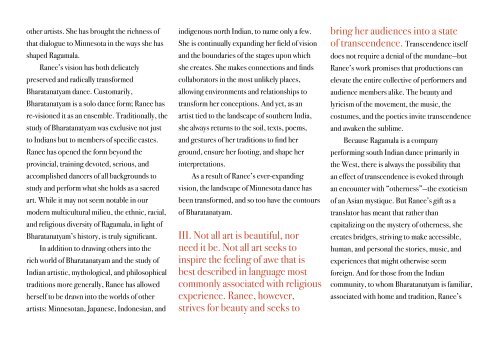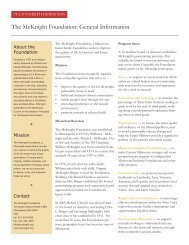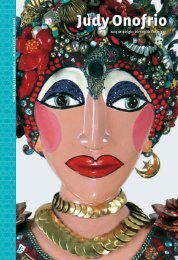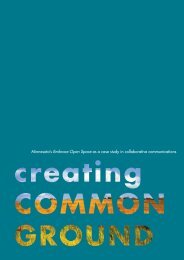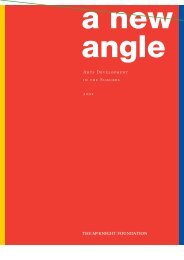PDF, 5 MB - McKnight Foundation
PDF, 5 MB - McKnight Foundation
PDF, 5 MB - McKnight Foundation
Create successful ePaper yourself
Turn your PDF publications into a flip-book with our unique Google optimized e-Paper software.
other artists. She has brought the richness of<br />
that dialogue to Minnesota in the ways she has<br />
shaped Ragamala.<br />
Ranee’s vision has both delicately<br />
preserved and radically transformed<br />
Bharatanatyam dance. Customarily,<br />
Bharatanatyam is a solo dance form; Ranee has<br />
re-visioned it as an ensemble. Traditionally, the<br />
study of Bharatanatyam was exclusive not just<br />
to Indians but to members of specific castes.<br />
Ranee has opened the form beyond the<br />
provincial, training devoted, serious, and<br />
accomplished dancers of all backgrounds to<br />
study and perform what she holds as a sacred<br />
art. While it may not seem notable in our<br />
modern multicultural milieu, the ethnic, racial,<br />
and religious diversity of Ragamala, in light of<br />
Bharatanatyam’s history, is truly significant.<br />
In addition to drawing others into the<br />
rich world of Bharatanatyam and the study of<br />
Indian artistic, mythological, and philosophical<br />
traditions more generally, Ranee has allowed<br />
herself to be drawn into the worlds of other<br />
artists: Minnesotan, Japanese, Indonesian, and<br />
indigenous north Indian, to name only a few.<br />
She is continually expanding her field of vision<br />
and the boundaries of the stages upon which<br />
she creates. She makes connections and finds<br />
collaborators in the most unlikely places,<br />
allowing environments and relationships to<br />
transform her conceptions. And yet, as an<br />
artist tied to the landscape of southern India,<br />
she always returns to the soil, texts, poems,<br />
and gestures of her traditions to find her<br />
ground, ensure her footing, and shape her<br />
interpretations.<br />
As a result of Ranee’s ever-expanding<br />
vision, the landscape of Minnesota dance has<br />
been transformed, and so too have the contours<br />
of Bharatanatyam.<br />
III. Not all art is beautiful, nor<br />
need it be. Not all art seeks to<br />
inspire the feeling of awe that is<br />
best described in language most<br />
commonly associated with religious<br />
experience. Ranee, however,<br />
strives for beauty and seeks to<br />
bring her audiences into a state<br />
of transcendence. Transcendence itself<br />
does not require a denial of the mundane—but<br />
Ranee’s work promises that productions can<br />
elevate the entire collective of performers and<br />
audience members alike. The beauty and<br />
lyricism of the movement, the music, the<br />
costumes, and the poetics invite transcendence<br />
and awaken the sublime.<br />
Because Ragamala is a company<br />
performing south Indian dance primarily in<br />
the West, there is always the possibility that<br />
an effect of transcendence is evoked through<br />
an encounter with “otherness”—the exoticism<br />
of an Asian mystique. But Ranee’s gift as a<br />
translator has meant that rather than<br />
capitalizing on the mystery of otherness, she<br />
creates bridges, striving to make accessible,<br />
human, and personal the stories, music, and<br />
experiences that might otherwise seem<br />
foreign. And for those from the Indian<br />
community, to whom Bharatanatyam is familiar,<br />
associated with home and tradition, Ranee’s


